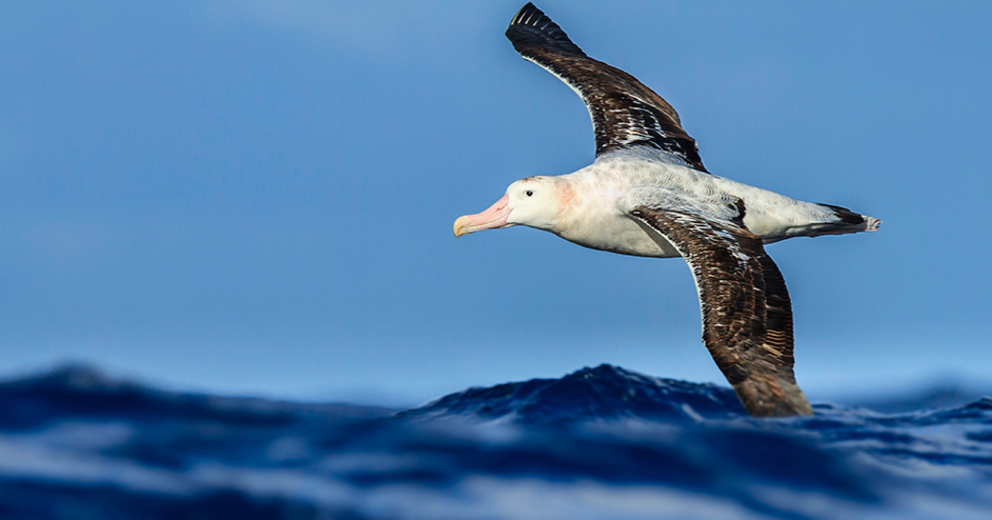‘Voice of the sea’ may help albatrosses catch the perfect wind
Low frequencies emitted by crashing waves may guide the birds to wind conditions that keep them aloft on long-distance flights
Given that the wandering albatross can weigh more than a 2-year-old child, it has some heavy lifting to do as it flies over vast swaths of open ocean. Finding good air currents can help, and these birds may search for them by listening for sounds that humans can’t hear. Researchers tracking the paths of these long-distance fliers report today in the Proceedings of the National Academy of Sciences that the very low frequency noise made by clashing waves influences the birds’ headings. The species joins a small but growing list of animals—including elephants, prairie dogs, and homing pigeons—that make use of such “infrasounds.”
The work is “of substantial significance,” says Tim Guilford, a zoologist at the University of Oxford who was not involved in the research. The technology used to reach these conclusions is “part of a new era in [the] study of animal behavior and ecology.”
Researchers have long wondered how wandering albatrosses (Diomedea exulans), which can fly more than 10,000 kilometers over open ocean in a single trip, make these journeys. Finding the right wind conditions, such as updrafts, to soar rather than flapping their wings, is key to conserving energy. Large waves can help generate those critical wind conditions, and may provide the birds with a sonic hint to their presence.
Big waves produce a very low frequency sound, below 20 hertz and beyond the limits of human hearing, that can travel thousands of kilometers, particularly when they collide with long distance swells, such as when storms develop. Samantha Patrick, an ecologist at the University of Liverpool was curious about whether the birds could key into these infrasounds—the “voice of the sea,” she calls it—to find the perfect wind.
On a previous trip, Patrick, postdoctoral researcher Natasha Gillies, and colleagues had traveled to Crozet Island off the coast of Antarctica, where these albatrosses breed, and outfitted 89 adult birds with GPS monitors that tracked the bird’s travels. They retrieved the data 1 year later when the birds returned for another breeding season. For a separate study, they collared the birds with biologgers containing tiny microphones that recorded the sounds, including infrasounds, the animals encountered.
For the new work, the researchers analyzed the GPS tracks, breaking them down according to whether the birds were resting, searching for food, or flying to a new location. Geophysicists on the team combined the biologger recordings with infrasound monitoring data from Kerguelen Island in the Southern Ocean to build “soundscape” maps on the birds’ journeys.
During their long-distance flights, the birds tended to change course whenever they encountered a loud infrasound, the team reports. The infrasounds often indicate wave turbulence, even storms—though it’s not yet clear how the birds make use of this information. The infrasound clearly impacted the birds’ behavior, although the scientists couldn’t identify a clear pattern of whether they avoided or aimed for these low frequencies.
Still, scientists think the sounds provide “a mechanism by which albatrosses may be able to identify favorable areas ‘on the fly,’” says Nathan Putman, an ecologist at environmental research company LGL Ecological Research Associates, who was not involved with the work. Especially on the open ocean, where there are few landmarks to navigate by, “it certainly seems likely that other birds could make use of this persistent environmental [cue].”
It’s a compelling idea, agrees Lesley Thorne, an ecologist at Stony Brook University who was not involved with the work. “But I don’t think it can explain everything” about albatross navigation, she says. “[The birds] are probably using a number of cues to navigate.”
Patrick and colleagues agree more work is needed to test the albatrosses’ hearing and learn how the birds incorporate infrasound into their other navigational tools, such as vision and olfaction. Guilford would like to see additional work investigate how albatrosses compose mental maps of their environment and whether infrasound plays a key role. This is “just the first step towards demonstrating that these birds are really using infrasound,” he says.

